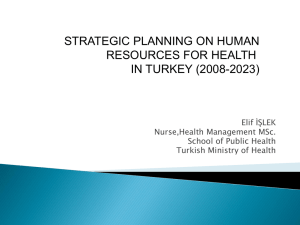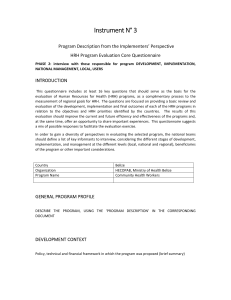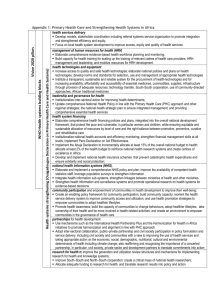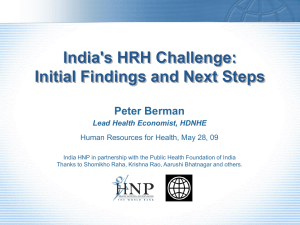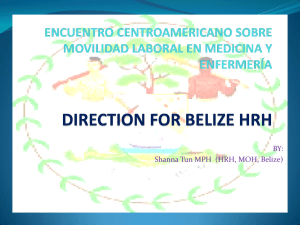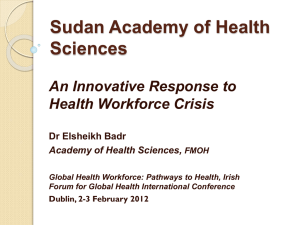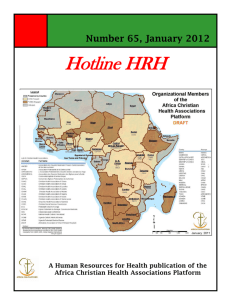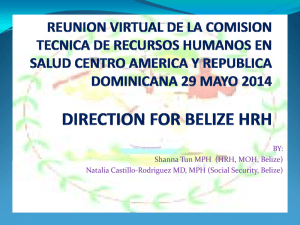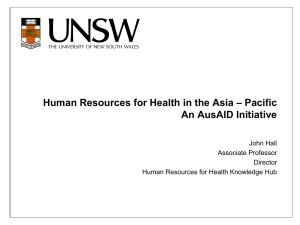Instrument N° 1 Inventory of National Programs HRH Program Evaluation Questionnaire: Core Questions INTRODUCTION
advertisement
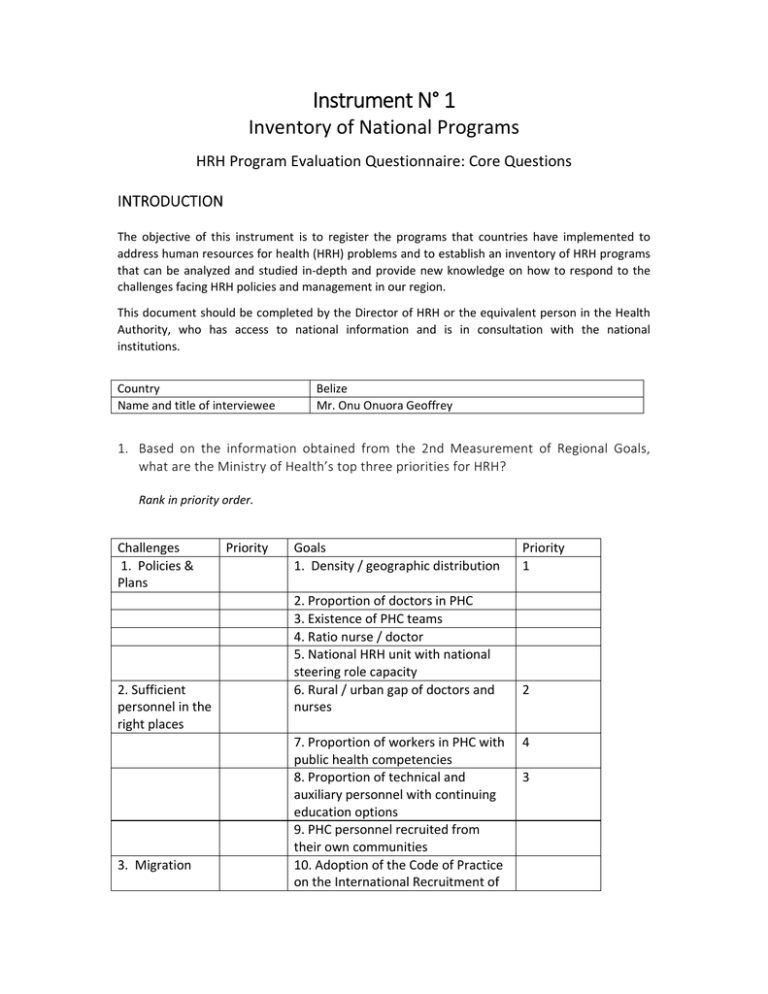
Instrument N° 1 Inventory of National Programs HRH Program Evaluation Questionnaire: Core Questions INTRODUCTION The objective of this instrument is to register the programs that countries have implemented to address human resources for health (HRH) problems and to establish an inventory of HRH programs that can be analyzed and studied in‐depth and provide new knowledge on how to respond to the challenges facing HRH policies and management in our region. This document should be completed by the Director of HRH or the equivalent person in the Health Authority, who has access to national information and is in consultation with the national institutions. Country Name and title of interviewee Belize Mr. Onu Onuora Geoffrey 1. Based on the information obtained from the 2nd Measurement of Regional Goals, what are the Ministry of Health’s top three priorities for HRH? Rank in priority order. Challenges 1. Policies & Plans Priority Goals 1. Density / geographic distribution Priority 1 2. Proportion of doctors in PHC 3. Existence of PHC teams 4. Ratio nurse / doctor 5. National HRH unit with national steering role capacity 6. Rural / urban gap of doctors and nurses 7. Proportion of workers in PHC with public health competencies 8. Proportion of technical and auxiliary personnel with continuing education options 9. PHC personnel recruited from their own communities 10. Adoption of the Code of Practice on the International Recruitment of 4 2. Sufficient personnel in the right places 3. Migration 2 3 4. Work conditions 5. Education‐ service links Health Personnel 11. Policy on self‐sufficiency of HRH 12. Mutual agreements for recognizing professional practice 13. Proportion of precarious work conditions 14. Worker health and security policies 15. Managers with public health and management competencies 16. Conflict negotiation 17. Reorientation of training health personnel towards PHC 18. Training programs in health for underserved populations 19. Level of attrition in medical schools 20. Accreditation of medical and public health schools 7 6 5 2. Which HRH programs and key initiatives were developed to address these priorities, keeping in mind those that were already in progress? To elaborate on this list, use the following operational definition: a) OPERATIONAL PROGRAM DEFINITION A program is defined as a combination of coherent actions, activities or interventions that are linked by a final objective and with one or various political objectives that have specific resources (human, financial, material) to meet the objective and contribute to the achievement of concrete goals, implemented by a government, specifically in HRH, with the objective to improve health conditions of the population. Program One ___CHWs___________________ (describe the program briefly) CHWs: Is an acronym for Community Health Workers. “CHWs” is a program that dates back to 1982 in Belize, developed to address the Human resources in health challenges especially in rural Belize. Back then, it was established through technical and financial support from the United Nations Children’s Fund (UNICEF). Recently, the Ministry of Health Belize in partnership with the United States Peace Corps is restructuring the program through retraining of CHWs to adapt them to their new role evolution as the base of the Belize primary care. Under this new initiative, the US Peace corps members will work closely with CHWs within the community setting where they live to provide primary care services ranging from health promotion to specific protection. Program Two ___Nigerian TAC/ Cuban Medical Brigade____ (describe the program briefly) An outcome of the Belize Government international Cooperation in health is the signing of memorandum of understanding with Nigeria and Cuban government in the area of Human Resources for Health. To that effect and under this arrangement, the Nigerian Government provides the government of Belize requested HRH that would allow Belize to meet its workforce shortage with both countries bearing the cost as spelt out in the agreement. This agreement is that of mutualism since there would be knowledge transferred to the Nigerian Volunteer at the end of the two year period. In the same way, the Cuban government deploys the Cuban medical brigades that provide healthcare services to rural dweller for two years period. SELECTION OF THE PROGRAM TO BE EVALUATED Of the list of programs described, select which will be evaluated in depth, using the following criteria: ‐ ‐ ‐ ‐ ‐ ‐ CRITERIA Relation with the priority challenges and goals Effect (impact) on the health system Amount of program financing Reach of the program (population, geographic area) Temporary extention (more than one year) Availability of information Program Selected ____CHWs__________________ IMPLEMENTATION OF THE PROGRAMS UNDER DEVELOPMENT IN THE COUNTRY 3. What are the key successes of the HRH program implementation process in relation to the overall health objectives? Describe. ‐ Imroved Access to culturally sensitive primary care 4. What are the key lessons learned in the implementation process of HRH programs? Indicate all that apply. Describe. ‐ ‐ ‐ The lesson learned is that the CHWs services are growing in relevance The commitment of CHWs are unequalled, even in the face of finacial challenges The program is evolving with periodic trainings, monitoring of activities and progress. 5. What are the biggest challenges? Indicate all that apply. Describe. ‐ ‐ The biggest challenge is lack of political will Financial constraint is also an issue to reckon with. 6. How could the current HRH implementation process be improved? Describe in relation to the challenges identified above. PROGRAM OUTCOMES 7. What difficulties still persist with respect to attaining the HRH objectives? List and describe. Political support __________________________ Participation levels __________________________ Program budget __________________________ Program coordination __________________________ Program implementation _________________________ Clarity of goals ________________________________ Program design ___________________________________ Lack of role clarity ________________________________ Lack of data/information support ___________________ Other ________________________________________________ 8. How have the HRH programs contributed to strengthening the health workforce? Describe. ‐ ‐ The CHWs are now better placed, more than ever before, to deliver some level of primary care within the community setting where they live. Much stress taken off from both human and material resources at other levels of care due to services of the CHWs. 9. How have the programs improved the provision of health service delivery? Describe. Mark all that apply. Primary Health Care expanded____________ Program efficiency increased _____________ Program effectiveness enhanced __________ Equity of services ______________________ Improved access to services ______________ Comprehensiveness of care improved _______ Patient satisfaction increased ______________ Patient wait‐times reduced ________________ Patient re‐admission rates reduced ________ Percentage of services provided by qualified staff increased ________ Other ___________________________________________________ 10. What new HRH programs or interventions are needed to advance the HRH agenda? List and describe. ‐ ‐ Recruitment and retention strategies Special incentive schemes to attract workforce to rural Belize
